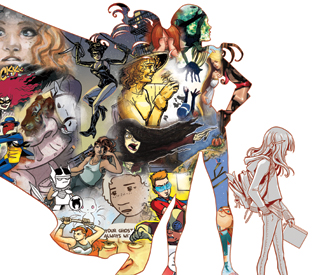LIT It started with a tweet. On May 17, 2011, Renae De Liz, following up on a suggestion by fellow comic book artist Jessica Hickman, pitched “an anthology made by all females” to her Twitter followers. The immediate response was unprecedented, as was the support that funneled in through the Kickstarter that was launched in July.
Approximately 10 months later, De Liz’s proposition has come to fruition in Womanthology: Heroic (IDW Publishing, 300pp., $50), an appealing hardcover coffee-table book showcasing female creators, ranging from first-timers to experienced professionals. Its stark cover depicts a young girl, armed with pencil and sketchbook, whose majestic shadow is populated with colorful images from the short comics within. Along the bottom, it boasts, “Created by over 150 women!”
In the intervening time since the anthology was conceived, the gender divide in mainstream comics has remained as wide as ever. Creative and personnel decisions in DC Comics’ “New 52” reboot initiative have sparked controversy — one impassioned fan, known as Kyrax2, showed up at last year’s San Diego Comic-Con dressed as Batgirl to question DC Entertainment co-publisher Dan DiDio about the paucity of female creators on DC books. As the Big Two continue to ignore or sometimes lazily placate their significant female fan base, as well as male fans tired of the industry’s chauvinistic leanings, the need for a production like Womanthology becomes ever greater.
The stories in the anthology, which occupy about 80 percent of the book, are all fitted to the subtitular theme, “Heroic.” Interpretations range broadly, from uplifting tales of familial bonds to riffs on the archetypal superhero origin. There’s a general tendency toward stories about women of all kinds, and this is never alienating to a male reader — superhero comics publishers who think young boys or men won’t connect to female characters, eat your hearts out. But for fans of other genres, never fear — there are works here with fantasy, horror, or espionage at the forefront, with tones ranging from grotesque to romantic to slickly exciting.
Most of the works are five pages or less, with many pin-ups and single-page pieces scattered throughout, so the best ones thrive on a clever high concept or a particularly arresting art style. A litany of short commentary on several stories rather defeats the purpose of the book’s emphasis on immersion in the diverse talents of women creators, but a few highlights are worth special mention. Vera L’s one-page Cambrian Explosion relates the origin story of a hero granted powers by fossils across a single panel and mock cover, in smooth manga-derived style, a seemingly perfect portfolio piece that conveys the idea’s creative possibilities in short order. A similar efficiency is achieved by Miss Lasko-Gross’s Perry Bible Fellowship-esque single-page strip.
Jenn Corella and Chrissie Zullo’s sci-fi thriller short Solace and Megan Lavey-Heaton and Isabelle Melancon’s imaginative drama Warrior also make the most of their brevity, leaning heavily on visual storytelling — and well they should, as both feature stunning art. Other works suffer somewhat from the constraints of an anthology: Annie Nocenti and Alicia Fernández’s What’s Lost Is Lost and Jessica Daniel and Candice Reilly’s Veil Between Realms are both aesthetically beautiful and rich with ideas — Nocenti’s prose is among the best in the volume — but they are frustratingly cryptic. Perhaps they would serve as great teasers for ongoing stories, though.
The collection is formatted with a great enthusiasm for all of the project’s participants. Each story is accompanied by blurbs on and often photographs of its creators, and the book’s comics content is broken up into sections to highlight the five editors who handled the many submissions (e.g. Team Jessica, Team Mariah, and so on), with another partition for some especially impressive work by kids and teens. This is intended as a sort of facebook (in the older sense) of up-and-coming talent, a networking tool as much as a source of inspiration. It is also run through with pro tips from various contributors, and features appendices of tutorials, interviews with pros, and profiles of underappreciated women of the past.
With all this apparatus for professional development, Womanthology is perhaps an odd object for the regular consumer, but it offers enough to get excited about that most readers won’t mind. And with IDW’s announcement at WonderCon of an ongoing series, Womanthology: Space, coming in September, this lovingly assembled project may serve as a springboard for lots of promising work in a variety of genres and formats.

